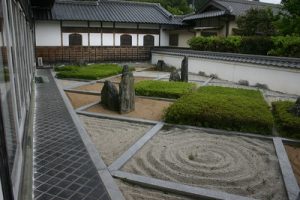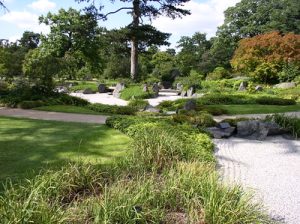Significance of Zen Gardens
My name is Joshua Currie and my portfolio revolves around Zen gardens and Zen gardening in Japan.
Introduction
Zen gardens are areas of land that are stylized landscapes located primarily around Japan. Zen gardens commonly all share similar features such as maticulously placed rocks, gravel, sand moss and other greenery. The purpose of zen gardens is to aid visitors in promoting medication and a calmer state of mind. Raked sand and gravel into wave like patterns are meant to encourage a state of mindfulness and relaxation. Zen gardens are commonly seen near Buddhist temples, historically to offer monks a place to mediate Buddha’s teachings, however, the Zen gardens themselves do not have to directly be affiliated with religion.

Themes
There are two main themes that emerge from Zen gardens and their philosophy.
Firstly, Zen gardens and their elements represent the natural world around us. The numerous rocks and stones places around the garden represents mountains that are rigid and immutable while the raked sand and gravel mixture is used to represent waves and fluidity. This relationship between the immutable rocks and the fluid sand and gravel help to create a dualistic relationship of yin and yang.
Secondly, Zen gardens are meant to promote relaxation and stillness in the mind, rather than to stimulate the mind and senses. This in turn encourages meditation or at the very least allow visitors to have a calmer state of mind. The use of minimum materials help further this theme.

Analysis
Zen gardens were first created in Japan during the their medieval period in order to allow monks and followers of Buddhism and the teachings of Buddha a place for meditation and to reflect upon the teachings of Buddhism. More specifically, Zen Buddhism, a school of Buddhism, that focuses on understanding reality and one’s own nature to achieve enlightenment. The rocks, sand, and gravel help to promote peace of mind which in turn help meditate on the teachings of Buddhism.
Even the act of forming and creating the Zen gardens using rakes and meticulous placements of objects help to achieve a calm and meditative state as well. This is due to the repetitive and rhythmic act of forming the Zen gardens that required concentration and a calm mind.
The photos in this portfolio showcase numerous Zen gardens that were created for the purpose of meditation and to promote a calmer state of mind. Sand and gravel that has been raked can be seen in all the photos that represent waves of water as well as fluidity. The rocks in the photos represent mountains as well as rigidness.

Application
The significance of Zen gardens is still prevalent today. While the origins of Zen gardens were used as places for meditation and reflection on Buddhist teachings, Zen garden are still known around the world for its unique take on gardening and philosophy. Instead of extravagant and colorful flowers, plants, and greenery seen in other gardens, Zen gardens strive on its focus on simplicity. It allows visitors to appreciate this unique take on gardening and give themselves a nice sense of calmness. The popularity of Zen gardens have become so widespread, many around the world have create their own Zen gardens in their backyards or have created miniature Zen gardens that can be transported indoors.
Media Attributions
- Zen Garden © timtak is licensed under a CC BY (Attribution) license
- Zen Garden © WindRiver is licensed under a CC BY (Attribution) license
- Abstract Zen Garden © aforero is licensed under a CC BY (Attribution) license

